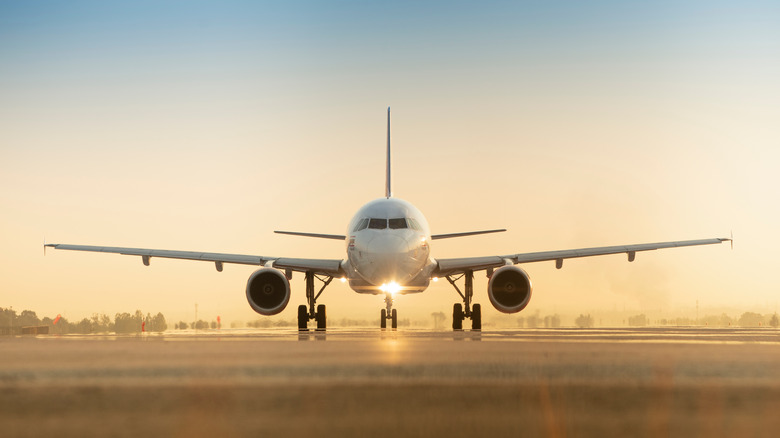How To Calculate The Number Of Miles You've Earned From Your Flight
It's easy to assume that frequent flyer programs have been around for just about forever. While airlines were certainly tracking miles traveled per passenger throughout the '50s and '60s, it wasn't until 1979 that the concept of earning frequent flyer miles really took off. The idea is often credited back to Texas International Airlines which boasted the very first mileage-based program before eventually consolidating with Continental in 1982, according to The Points Guy.
By 1981, United Airlines and American Airlines had both officially launched their own mileage programs. Since that time, earning miles for travel has become a fairly standard expectation across airlines globally. However, calculating the number of miles you'll earn from each trip has changed dramatically in recent years.
Once upon a time, the process was refreshingly straightforward. In the beginning, frequent flyer programs typically dictated that travelers would earn a mile for every mile flown. This made it easy to know what you would earn based solely on how far you were going.
These days, the reality of calculating airline miles earned is vastly different as airlines move away from a mile-to-mile standard and towards revenue-based mileage programs instead. Under the terms of these programs, passengers earn miles towards future travel based not on how far they've flown, but on how much they spent on a ticket. The result is a much more complicated program where it's necessary to understand the nuances to determine what you'll actually earn upon landing.
The move towards revenue-based mileage programs
The universal standard of mile-to-mile programs first began to shift in 2009 when JetBlue decided to overhaul its loyalty program for something new. According to Nerdwallet, they were the first U.S. airline to implement a revenue-based approach to earning miles known as TrueBlue. Southwest Airlines followed suit in 2011 with the creation of its program known as Rapid Rewards. By 2015, Delta was utilizing a revenue-based mileage program as well, and American Airlines was the next to adopt this approach to earning miles.
Today, this is the format nearly all major U.S. airlines follow. However, each incorporates its own unique differences regarding how miles and points are awarded to passengers. While the idea of earning miles based on ticket price is common within a revenue-based mileage program, the details certainly differ from airline to airline.
The miles a passenger actually earns per flight are typically calculated solely on what's invested in the cost of a ticket before any fees or relevant taxes are applied. This can make figuring out eligible spending in relation to miles earned complicated, to say the least. Especially when you consider that a revenue-based mileage program doesn't take seat assignment fees, airport fees, or checked bag fees into account.
Fare type and status make a difference
Currently, passengers can earn miles for every eligible dollar spent. Many of the major U.S. airlines today set this at around 5 miles per dollar, according to Nerdwallet. However, those miles earned fluctuate depending on whether a passenger has booked a first-class ticket or an economy-class ticket.
In some cases, the terms of these revenue-based mileage programs mean there's nothing to be earned at all. On December 9, 2021, Delta Airlines adjusted its program to exclude basic economy fares from its SkyMiles program. Meanwhile, across the major U.S. airline loyalty programs, passengers who hold elite status can earn more. This can range from 7 miles per dollar to 9 miles per dollar, depending on the status tier. While this can improve mileage earnings, it's yet another factor to add to the overall calculation process.
In the past, it may have been worth your time to try and calculate miles earned on your own. These days, a more efficient and far less stressful route is to turn directly to your airline's website. Major carriers like United, Delta, and American all display miles earned as soon as you log into your loyalty program account. Mileage earned appears as you move through the digital booking process. A quick look can help you anticipate your earnings. Then, you can easily adjust your fare if you want to earn more miles along the way.


